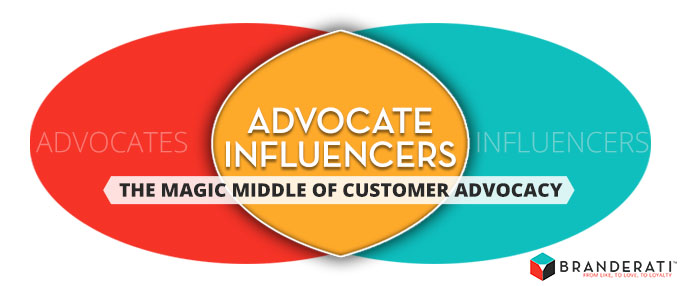Brand advocates are the new window display in your marketing tool box. In an age where advertising is becoming ever more fragmented, having the right advocates on board is essential for reaching your customers, as well as getting your message out to new audiences.
There is an ongoing debate as to whether it is better to invest in influencers, who have a large following but are not necessarily committed to your brand, or in advocates, who are so passionate about your product that they will rave about it to their friends for no incentive at all… but do not necessarily have the necessary wide reach the marketers are so keen on getting.
But why not the golden middle, the intersection of both? At BRANDERATI we coined a term advocate influencers. Advocate influencers are people who are passionate about your brand but have the ability to reach a large audience as well. And if this group of people doesn’t exist for your brand, why not create and enable it?
Think of the world of sports advertising: the top sportspeople are going to use the top brands when they compete, so asking a number one ranking sports star to endorse your product seems a natural fit. When you see a sports star as the face of Nike, you believe in their advocacy because chances are that they would use the sports brand out of choice: they are a natural convert.
The problem with using celebrity endorsements is that it is still a short-term solution. Sports stars rise and fall, and the audience still knows there is money changing hands and so there is less trust in the message than if an advocate was endorsing a product from passion alone.
The key to a long-term marketing strategy that engages fans and converts them into brand spokespeople is putting in the groundwork to build a really solid foundation. You need to be thoughtful in the way you find your advocate influencers, the way you recruit them, the way you engage them and how you build relationship with them. Not only that, I would go so far as to say that you can actually help your best advocates become influencers. Very few brands are willing to commit the time and resources to make this a reality, but those that do are rewarded by real commitment from their customers and increased sales impact. We’ve seen it happen with the number of our clients, and not once.
But what if you don’t have many influencers among your known advocates? Not a problem. To truly drive impact the goal is to create a wide reach, but whereas one influencer might have a large following, remember that several advocates may have a similar sized audience between them – and not only that, but their networks will be full of people like them i.e. the perfect target demographic for your brand. So it is worth the time and effort building your advocate network, even if your advocates only have a small following each. Together, they will build a wide audience of exactly the sort of potential customers you would like to see engage with your brand (let alone buy your product).
Case in point? A clothing company Jac Vanek.
The brand worked hard to engage 4,000 Brand Ambassadors, customers who worked on their behalf to “exponentially increase the amount of positive recommendations, reviews and mentions about their brand and its products and services.” By putting in the hard work to identify loyal customers who were willing to talk about the brand, Jac Vanek estimated a six times return on their investment. Although these were ordinary customers, their combined reach was 14 million impressions because of the cumulative effect of their networks.
Relevancy and context are key for advocacy and influencer programs. (click to tweet) You might approach a ‘celebrity’ blogger with a huge following for an endorsement on their site and achieve a high number of hits on your website, but the conversion rate will not be as high as for a blogger who is already on board with your message: chances are that his/her readership, as well as his/her community’s willingness to listen and engage with the message, will be a better fit for your product. Imagine if a watch company sent their latest sports watch to a blogger with a large following who wrote about entertainment. They might mention your product, but only a small percentage of their readership would be interested in sports watches. Now imagine if you had a fan on your Facebook page who blogged about running. That fan might only have a small following but (s)he is a natural customer for your watch, and so is his/her readers. It is worth the time and effort getting to know your fans, investing in them, and engaging with their communities. They will be naturally more enthusiastic and their passion is more likely to bring new audiences, and with it, new customers.
Advocacy is about quality, not quantity. (click to tweet) Passion spreads quickly through networks and will stand out above apathetic messages. (click to tweet) So it’s time for us to stop collecting fan/followers/subscribers and start activating them through meaningful and long-term relationships!
Originally published on FastCompany
Brand advocates are the new window display in your marketing tool box. Click To Tweet Advocate influencers are people who are passionate about your brand but have the ability to reach a... Click To Tweet Advocacy is about quality, not quantity. Click To Tweet Passion spreads quickly through networks and will stand out above apathetic messages. Click To Tweet So it’s time for us to stop collecting fan/followers/subscribers and start activating them... Click To Tweet
